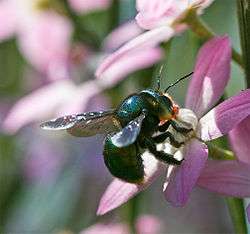Xylocopa aerata
| Golden-green carpenter bee | |
|---|---|
 | |
| Female | |
| Scientific classification | |
| Kingdom: | Animalia |
| Phylum: | Arthropoda |
| Class: | Insecta |
| Order: | Hymenoptera |
| Family: | Apidae |
| Genus: | Xylocopa |
| Species: | X. aerata |
| Binomial name | |
| Xylocopa aerata (Smith, 1851) | |
| Synonyms | |
|
Lestis aeratus | |
The Golden-green carpenter bee, Xylocopa aerata, is one of two species of carpenter bee found in the Sydney region of New South Wales in Australia. It gets its common name by its habit of burrowing into wood.
It was originally described by F. Smith in 1851 as Lestis aeratus.[1] Its specific epithet is the Latin adjective aerata, meaning "bronzed".
As its name implies, the Golden-green carpenter bee is a metallic green in colour, although it may appear purplish or bluish from some angles. A large stocky bee, it is often heard by its loud low-pitched buzzing while flying between flowers. The male has yellow face markings. The bee does have a sting which is potentially painful, although no stings have been recorded.[2]
The natural distribution is southeastern New South Wales from Sydney southwards (where it overlaps with X. bombylans), and into Victoria and southeastern South Australia.[3] They can be seen from spring to autumn, commonly feeding at pea flowers of the family Fabaceae, such as Gompholobium species, including Gompholobium latifolium in spring, and Pultenaea elliptica in autumn. Flowers of Leucopogon and Leptospermum are also visited.[3]
The Golden-green carpenter bee nests by hollowing out stalks of grasstrees (Xanthorrhoea), or soft wood such as Banksia, Casuarina, Melaleuca and Leptospermum. The female excavates a tunnel with her jaws and picks up and dumps the wood shavings outside. The hollow can reach 30 cm long by 1.1-1.4 cm diameter. Larger pieces of wood may allow for multiple tunnels. Several female bees may use a nest, one breeding and the others guarding. A bee defends the 0.7-1.0 cm wide entrance by blocking it with its abdomen (compare Allodapula). Both male and female bees may overwinter within the tunnels. The tunnels are partitioned into several cells, where the mother bee lays an egg in each accompanied by provisions of nectar and pollen.[2]
References
- ↑ Smith, F. 1851. Notes on the habits of Australian Hymenoptera. Transactions of the Entomological Society of London ns 1: 179–181, pl. xvi figs 4, 5 [180].
- 1 2 Dollin, Anne; Batley, Michael (2000). Native Bees of the Sydney Region. North Richmond, NSW: Australian Native Bee Research Centre. pp. 58–59. ISBN 1-876307-07-2.
- 1 2 Species Xylocopa (Lestis) aeratus (Smith, 1851) Australian Biological Resources Study Australian Faunal Directory